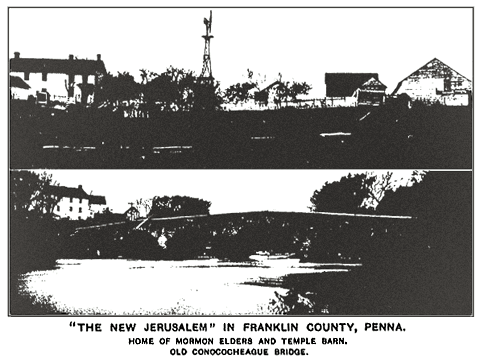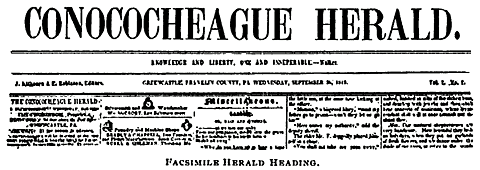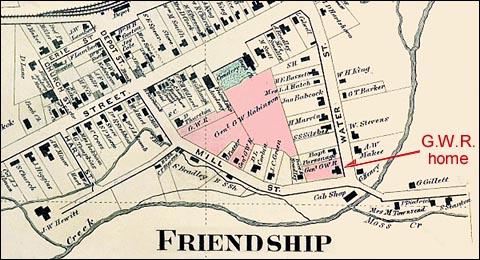
Mormon Classics | Spalding Library | Bookshelf | Newspapers | History Vault
|
SIDNEY RIGDON
AS PORTRAYED IN THE POST-NAUVOO PERIOD |
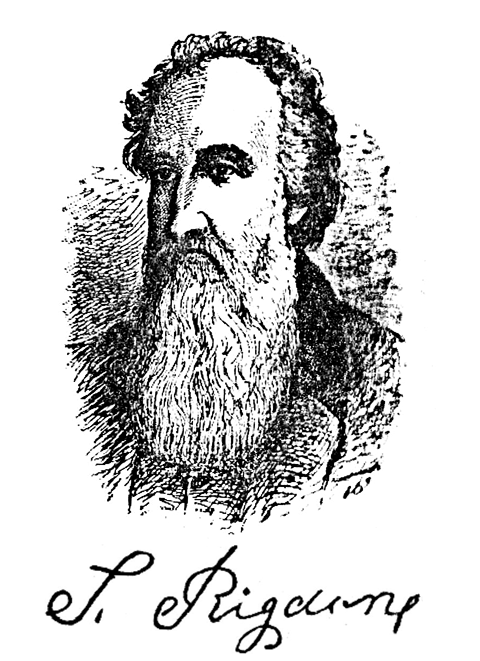
|
The Fictional Rigdon | B. M. Nead's "Birth-Place of Mormonism" | 1952 Arch Merrill book
T. J. Gregory's "Rigdon: Post Nauvoo" | Van Wagoner's Sidney Rigdon | 1873 letter
|
Austin Cowles (1792-1892) "Mormons... Sketches" (Rochester: Moore's Rural NY, 1869) |

|
 Rochester, New York -- January 2, 1869 Historical THE MORMONS: Pen and Pencil Sketches Illustrating their Early History. I. _______________ BY A. W. COWLES, D. D. _______________ 
MORMON HILL OR HILL CAMORA, MANCHESTER, ONTARIO CO., N. Y. Here Joe Smith claimed that the Golden Bible was found. The above is taken from the road a little to the North of the "Big Tree," called "Joe Smith's Willow." THE rise of a new religion in the midst of the nineteenth century, under the very eyes of our [most] intelligent civilization and in the very center of one of the most highly favored districts of Western New York, is an event that may well excite the attention and interest of every thoughtful mind. The birth of a new faith, the promulgation of a new revelation, is far more rare and strange than the beginning of a new nation. Yet many of the first organizers of the Mormon Church are still alive. The first preacher still lives. Many still remember the first prophet and seer, who gravely asserted his divine commission to discover and translate a new volume of the word of GOD, and to introduce a new and complete dispensation of doctrines, prophecies and miracles, with new promises of earthly prosperity and new securities for eternal salvation. |
 Rochester, New York -- January 23, 1869 Historical THE MORMONS: Pen and Pencil Sketches Illustrating their Early History. II. _______________ BY A. W. COWLES, D. D. _______________ 
Sidney B. Rigdon, The First Mormon Preacher. THE two most important personages in the earliest days of Mormonism, next to the chief seer, Smith, were Martin Harris and Sidney B. Rigdon. Harris furnished money and Rigdon "brains" for the new movement, for the Smith family were lamentably wanting in both these important requisites for a new religion. Harris was the first convert who had property. All the rest were dependent on their daily labor for a precarious livlihood. Harris had a good farm and was in comparatively easy circumstances. He was, however, a weak, credulous man, very ignorant, and yet a constant reader of the Old Testament. It is said that he learned the whole of it so as to be able to repeat it from memory, and could give chapter and verse for almost any passage. He seemed to himself to have conquered the whole province of revelation, including narratives, doctrines, prophecies and mysteries; and, like a greater personage of olden time, he sighed for a new world to conquer. Familiar with the old Hebrew prophets in his way, and with his own interpretation of their sublime visions, which he of course readily exhausted, he was ready to hail with delight a "live prophet," even if he did, to all human vision, seem like an idle vagabond. This doubtless added to the sacredness of his prophetic character, in his eyes. It perhaps was the weird eccentricity of one familiar with strange visions and mysterious revelations. At any rate, Harris gave all the mind he had and all the influence he could command to the new prophet. He was most thoroughly convinced of the divine mission of Joe Smith. He devoted his time to the new faith, and at length mortgaged his farm to raise means for printing the new Bible. His wife, who had no sympathy for what she fully believed to be the insane delusion of her husband, refused to sign the mortgage, and the alienation became so serious that they separated. Harris persisted in his efforts to publish the New Scriptures of the Mormon faith, and at length an edition of 5,000 copies was printed at a cost of $3,000. One of the printers has now in his possession the original sheets from which the first edition was printed. |
 Rochester, New York -- March 20, 1869 Historical THE MORMONS: Pen and Pencil Sketches Illustrating their Early History. III. _______________ BY A. W. COWLES, D. D. _______________ 
SACRIFICE OF A BLACK SHEEP. To keep the Devil away when the golden plates of the Mormon Bible were found (?) (See first article on Mormonism.) IT is unquestionable that Sidney Rigdon was the real master spirit of the Mormon Church from the time he united his faith and his fortunes with the new movement. He was a ready speaker, a fluent controversialist, having at command new and plausible theories, with a love of contradiction and startling novelties of interpretation. He had gathered a congregation at Mentor, Ohio, of such materials as would naturally cluster round such a man. He had evidently unsettled his own faith and that of large numbers of his hearers in the generally received interpretations of the Old Bible. He was eccentric and bold, and among plain, uneducated people, passed for an oracle. He was ripe for a new religion -- ready to listen to a new revelation. |
|
Benjamin M. Nead (1847 -1923) Birth-Place of Mormonism (Cambersburg, PA: Valley Spirit Press, 1897) |

|
see also: History of Franklin Co., Pa., 1887 | Waynesboro, the History, 1900
|
[ 1 ]
To properly study the beginnings of most of the mighty centralizing forces which have lifted this great Country of ours into its present proud position, it is now being recognized as a fact, that we must come into Pennsylvania to find the central point from which these forces radiated. This proposition is applicable to the subject in hand, viz: Mormonism, as well as to many of the more orthodox religious and semi-religious movements which a century and a half ago, gave such an impetus to Civilization. The credit or discredit, according to the point of view taken, for devising the scheme of the "Latter Day Saints," or the Mormon Society, has by common consent been accorded to Joseph Smith, a native of the State of Vermont, but sometime a resident of southern New York and northern Pennsylvania, particularly during the early "inspired period" of his career. To the shrewdness and bold method of this remarkable man, the success of the initiatory steps of the scheme is due. However, without the assistance 2 of two or three residents of Pennsylvania if tradition be correct, the Mormon Bible and the mysterious method of its production would have been lacking in much of romantic detail.* * * There was a tradition amongst the North American Indians, that certain peculiar crystals of salt enrusted stones, found in the saline lakes and springs of the country, possessed magical properties and when properly used, would indicate the presence of gold and precious stones. This superstition was well known to the early settlers of the country. Around the salt springs in the neighborhood of Syracuse, N. Y., which are mentioned as early as the year 1689, were many Indians, and it is therefore not surprising to find traditionary traces of the "seeing stone" in that neighborhood even as late as the first and second decades of the present century. About the time when Joseph Smith, a boy of fifteen, came to settle with his father in southern New York tradition has it, that a certain drawer of salt, residing at Salina, Jack Belcher by name, who afterwards removed to Gibson township, Susquehanna co., Pa., had found there and had in his possession, a wonderful "seeing stone." He created no little excitement among his neighbors, by the wonderful discoveries he was making by means of his magical stone. Anything that was lost could be found through its means, and it was reputed an infallible guide to the whereabouts of precious metals. The young "seer" Joseph, across the line in New York, heard the story of this wonderful stone and the principal mission "revealed" to him just then, was not the founding of a church, but the finding of gold and silver and other precious things hidden in the earth. He at once knew and apprehended the worth of this wonderful "seeing stone" and its value to him. He sought out its owner and secured 3 the stone and for quite awhile among the money-diggers of the region, he maintained a reputation as a gold and mineral "smeller" and quite an extensive and lucrative clientage.* * * There rests in a quiet grave in the burying ground at Amity, Washington Co., Pa., the remains of a man, over which has been erected a monument bearing this inscription:
IN MEMORY OF In the year 1812 Solomon Spaulding came to Pittsburgh. He brought with him a copy of his work "Manuscript Found" and submitted it to the Rev. Robert Patterson, a printer in that city, with a view to its publication. Mr. Patterson never published the work and the subsequent history of the MS. is enshrouded in doubt. It is claimed by some authorities that the MS. was stolen and copied while in Mr. Patterson's possession, by one Sidney Rigdon, but the weight of the evidence is against this story and it is now generally believed that the MS. came into the possession of Rigdon by other means and was held by him as a curiosity until subsequent events suggested 4 a new value to it. Sidney Rigdon was a bright talented man and had a checkered career. "Too lazy for a farmer" he became a minister and was the pastor of the First Baptist Church in Pittsburgh, from 1822 to 1824, in which last mentioned year he was excluded from the ministry for doctrinal heresies. It is believed by the best authorities, that Spaulding's MS. came into his possession during this period and was given him by a friend as a curiosity.* * * How Sidney Rigdon, imbued with the quaint fancies of Spaulding's MS. and Joseph Smith with Belcher's "seeing stone," managed to form a partnership and evolve the Mormon scheme, does not fully appear; but the story runs, that through the good offices of one Parley P. Pratt, once a peddler but subsequently an elder and trusted preacher of the Mormon faith, Rigdon and Smith were secretly brought together. Joe Smith was living at Harmony, now Oakland, Susquehanna Co., Pennsylvania. The "seeing stone" had made many friends for him in the neighborhood. He had found a wife there, also, Emma, daughter of Isaac Hale, a most estimable citizen. After the visits of a "mysterious stranger" at the Smith residence in Harmony, the story of the finding of the plates of the "golden bible," began to crop out and subsequently the whole plan of its translation was "revealed." Shortly after his marriage Smith sojourned with his wife at Palmyra, N. Y. While there he had a "vision." He saw a packet of gold plates hidden in a hill not many miles away. In company with his wife, he set out for the designated spot; but being warned in a dream that his wife should not approach too near the sacred spot, he commanded her to stop at the foot of the hill, while he, on horseback continued to ride up, until his horse halted its nose against a tree 5 Following further the inspired instructions he searched at the roots of the tree and found the sacred plates. Secretly removed by him these plates were hidden by Smith under his hearth-stone at Palmyra until his departure to Harmony, when he took them along with him stowed away in a barrel of beans.These plates were so sacred, according to the "revelation" that no one was permitted to touch them but the first-born son of the "prophet" who found them. This part of the programme was slightly interfered with by Smith's first-born son proving to be a daughter, who died and lies buried in the old McKune graveyard at Harmony. However another "revelation" readily cured this little mishap. In a room of his house at Harmony, Joe Smith set up a blanket. From behind this sacred veil, he divulged the wonderful story of the discovery of the "golden Bible," and read off through the magical glasses, containing the transparent stones "Urim" and "Thummim" the subject matter of the hieroglyphic plates, which, the skeptically inclined aver, in wonderful coincidence, assumed when translated form and substance strikingly in accord with Solomon Spaulding's MS. The interpretation was taken down on the other side of the blanket by two amanuenses. The MS. thus evolved was printed by the Wayne County Sentinel of Palmyra, N. Y., and subsequently was properly, and with much mystery promulgated as the fundamental law of the new religion which Joseph Smith founded and of which Sidney Rigdon became chief of the ordained ministers. * * * On the sixth of April, 1830, six "Saints" formally organized the Mormon Church at the home of Peter Witmer in the village of Fayette, in New York State, where the following Sabbath, Oliver 6 Cowdery, who had aided Smith as one of his amanuenses in translating the plates, preached the first sermon, baptizing several converts who presented themselves.In the early summer of that year, the building of the first temple, at Kirtland, Ohio, was decided upon. Whether through the malevolent influence of "Maroni," the guardian spirit, who was offended because of the prophet's carnel love for gold, and his lukewarmness in the faith, or through other causes, the "new faith" did not prevail mightily and prosper in Ohio and Missouri, as in the "revelation" it had been promised, it should. Joseph Smith, Sidney Rigdon and Frederick G. Williams were the chiefs of the church hierarchy established at Kirtland, and were styled the "first presidency." They inagurated a number of schemes, not wholly consonant with the proper walk and conversation of church Elders and Saints. One of these was a "wild cat" bank, without a charter. Smith was president and Rigdon was cashier. The country was flooded with notes of doubtful value. As a consequence the connection of these men with this affair and others of like character, brought them into disrepute, and they were both subsequently charged with fraudulent dealing. In November, 1837, the bank failed and Smith and Rigdon both fled between two days to escape arrest, and took refuge in Missouri. More "revelations" followed: declaring that the sins of Rigdon and Williams were forgiven, and henceforth they were to be accounted as equals with Joseph Smith, in holding the keys of his last Kingdom; another that Missouri was henceforth to be "the promised land of the chosen people." One trouble followed fast upon the heels of another, however, and these sanctified representatives of the new faith suffered much contumely 7 even unto imprisonment, and the being clothed about with a garment of tar and feathers. At length Missouri was abandoned, and the city of Nauvoo, in Illinois, became the objective point (1840). There they built a magnificent temple, and there was promulgated the doctrine of polygamy. Then it was that the people arose against them. Driven from Nauvoo, Joseph and his brother, Hyrum Smith, were shot and killed at Carthage, Ill., on June 27, 1844. This Rigdon considered to be his opportunity, and he aspired to become the leader of the sect, but the winning manners and seductive arguments of Brigham Young carried the SIDNEY RIGDON. "twelve apostles" to his side, and he was chosen instead of Rigdon. In his disappointment Rigdon refused to submit to the new authority, and for his contumacy, was cut off from the communion of the faithful, cursed, and solemnly delivered over to the Devil "to be buffetted in the flesh for a thousand years." Following this, Sidney Rigdon, who 8 had a considerable number of followers seceded and came eastward to Pittsburgh where a paper was established, as a medium through which to spread the doctrines of the new faith according to the apostle Rigdon. Public sentiment here was anything but in accord with these new and strange religious teachings, and after considerable excitement, and not a little contention with the civil authorities, backed up by representatives of the orthodox religious sects, Rigdon and his followers resolved to remove and to seek a more quiet neighborhood.While in Pittsburgh, Rigdon, being a native of the State, prepared and forwarded a memorial to the Pennsylvania Legislature, requesting that body to pass a resolution addressed to Congress, asking "that the delegation of Pennsylvania be instructed to use all their influence in the National Councils to have redress granted" for the destruction of the Mormon lives and property in the western country. Nothing seems to have been done with the memorial. * * * Almost within the shadow of the Cove mountain, near the western borders of Franklin County, Pennsylvania, spanning a tributory of the Conococheague Creek, stands to this day an old stone bridge. In the Autumn of 1845, two faithful believers in the doctrine promulgated by Joseph Smith, and later preached in a modified form by Sidney Rigdon, sanctified elders of the "Latter Day Saints," were sent eastward to spy out the land. After wandering many days, they at length, one charming afternoon, halted on this old stone bridge. Looking northward, their eyes rested upon a beautiful scene. What more beautiful picture is there than a Cumberland Valley farm! Through their inspired understanding, they at once realized that this was the place of their visions, where the Lord had shown them 9 was to be marked out the site of the "City of the New Jerusalem."On this occasion these representatives of the saints lingered around for some days gathering information and by their quaint manners and "solemn converse" winning many friends in the neighborhood, and then departed as quietly and mysteriously as they had come, to be followed in a few months by their financial representative, one Peter Boyer, who negotiated the purchase from Mr. Andrew G. McLanahan of his farm, lying on the turnpike between Greencastle and Mercersburg. This was the place which the advance agents had chosen as the site of a new Mormon city in the east. A little more than fifteen thousand dollars was the price agreed upon with Mr. McLanahan for his pretty farm, and Isaac McCauley, the Franklin County historian, tells us in his accurate and circumstantial way that the far, contained "four hundred acres;" that "four hundred dollars were paid in cash and on April 3d, 1846, Mr. McLanahan received five thousand four hundred dollars additional, gave a deed and took a judgement for the balance of the purchase money, eight thousand seven hundred dollars, payable April 1st, 1847." The representatives of the "Latter Day Saints" who settled on this tract of land, and in the neighboring town of Greencastle, including "strangers from the destruction of the West" and converts among the residents, numbered nearly two hundred. Those who dwelt in the town seemed to have some acquaintance with work and in distinction from many of those who dwelt upon the farm were averse to idleness. The town people started a paper, in the interest of their sect, which they called the "Conochoheague Herald," copies of which are still in existence. One Robinson, by name, was the editor and his paper, judging from the copy 10 which the writer has seen, the "Herald" was a sprightly little sheet.The plan for a great city and magnificent temple here was on the scale commensurate with the Mormon plans for cities and temples in the West. It is whispered, however, that at length the ancient unquelled spirit of acquisitiveness arose amongst certain of the leading Saints, and the angered spirit guide, "Maroni," again led them into paths which followed on to disaster. Sidney Rigdon was their chief "Seer" and prophet, and what knowledge Sidney lacked with respect to the business of a "Seer" and prophet was worth but very little. Moreover, he not infrequently essayed the role of a Merlin. He was High Priest as well as Prophet. The commodious barn on the rolling meadow was the "Temple" and the dwelling house nearby was the "temporal abode" of himself and his assistant priests, Kimball and Hyde [sic]. As a whole, the Mormons in Franklin County were a "serious folk," and most religiously inclined. The doctrine of polygamy, if entertained at all, does not appear to have been seriously asserted. The "Word of Wisdom," one of the revelations of the young seer Joseph," in the decade before, which inculcated "good habits," seemed to govern the conduct of many. Religious services were held ebvery Sunday in the temple barn, and under the earnest ministration of Rigdon and his assistants not a few converts were made, but the faith never came deeply grounded in any quarter of the county. There was a general awakening from the delusion, when on that eventful night the whole community under the lead of the High Priest Rigdon, clad in their ascension robes knelt on the meadow back of the barn, from sunset to the coming of dawn, awaiting the promised advent of the Messiah, all in vain. The awakening from their folly was sudden and complete, among the 11 shivering company that repaired to their homes when the light of morning came. 
As had been said the most of these people lived in idleness; what money they had brought with them, or had accumulated, 12 was soon spent. Their lands being only partially paid for they could not meet the balance of their indebtedness to the former owner when it became due, and he having "taken a judgement for the balance of the purchase money," sold out the saints and unceremoniously ejected them from the "New Jerusalem," within two years of their first coming. A majority of the scattered sect made their way west to Salt Lake City whilst others backslid to the Gentiles and started life anew. In a pine wood not far from the site of the New Jerusalem in Pennsylvania a number of their dead lie buried and the spot is to-day pointed out to the passer-by as the "Mormon Graveyard." Little is known as to the individuality of the men and women who there sleep their last sleep.* * * Sidney Rigdon was born in St. Clair township, Allegheny County, February 19, 1793, and died at the village of Friendship, N. Y., July 14th, 1876, declaring to the end his firm belief in the doctrines and authenticity of the "Golden Bible." * * * Brigham Young, notwithstanding statements have been made to the contrary, did not come east at the time of the Nauvoo dissolution but led the western contingent to Deseret (Utah), arriving in person in "the Land of the Honey Bee" in July 1847. He was never, so far as is known, with the Franklin County Mormons. The attitude of Sidney Rigdon toward him would have made his presence there anything but a pleasant episode. Brigham Young was not a native of Pennsylvania but was born in Whittingham, Vt., June 1st 1801, and died August 29th, 1877, a little over a year after Rigdon. BENJAMIN MATTHIAS NEAD. VALLEY SPIRIT, PR., CHAMBERSBURG, PA. Note: The material in this pamphlet is a condensation of Mr. Nead's article: "History of Mormonism," in Kittochtinny Historical Society Papers I 1923, pp. 411-427. |

|
Benjamin M. Nead (1847-1923) Waynesboro, the History... (Harrisburgh, PA: Harrisburgh Pub. Co., 1900) |
|
Arch Merrill
Shadows on the Wall (NYC: American Book-Stratford Press, 1952) Note: This text copyright © 1952 and other years by the Rochester Democrat and Chronicle Limited "fair use" excerpts only presented here. |
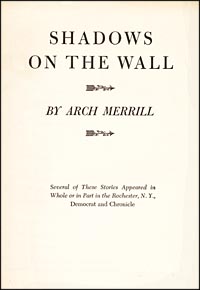
|
|
SHADOWS ON THE WALL BY ARCH MERRILL Several of These Stories Appeared in Whole or in Part in the Rochester, N. Y., Democrat and Chronicle
[ 95 ]
In Friendship Village stands a big white house that holds a mystery. There are iron bars across some of its windows. The man who put them there has been dead these 74 years. His name was George W. Robinson and his secret died with him. There is a tradition in the Allegany County village that those barred windows are somehow linked to Robinson's past as a Mormon official during the church's early troubled years in the West. Robinson was one of three Mormon exiles who came to live the rest of their days in the peaceful village with the reassuring name -- after their leader, Joseph Smith, was slain by a mob in Illinois. The other men were Edward B. Wingate and Sidney Rigdon. Big Ned Wingate, who, like Robinson, had married a Rigdon daughter, was said to have been an officer of the Danites, the secret police set up in Missouri, largely to ferret out heresy and treason in the Mormon ranks. The name of Sidney Rigdon was a famous one in the early annals of the church. He once had been second in command to Joseph the Prophet. Some have maintained he was the real author of the Book of Mormon, not the unlettered Palmyra farm boy, Joseph Smith. Rigdon had been a minister in Ohio, the finest pulpit orator in the Western Reserve. But when he came to Friendship around 1847, he was a broken, beaten man, cast out by his church after he had lost [ 96 ] his struggle for the mantle of the slain Joseph to Brigham Young. In their Southern Tier haven, Robinson, who reputedly had been a fiscal officer, a minor figure in the Mormon hierarchy, became an important man. He built a brick store and a mill and became president of a bank. The villagers called him "General" and his handsome house with the tall gables and the roomy porches at Main [sic - Mill?] and East Water Streets was a showplace of the town. But no one ever found out what fear drove the prosperous "General" to bar the ground floor rear windows of his home or what treasure he guarded there, not even trusting the vaults of his own bank. Village gossip, snowballing through generations, has built up tales of secret documents and money bags behind the barred windows. One story concerns the appearance of two strange men in Friendship. They were looking for the onetime fiscal officer of the Church of Latter Day Saints. Hearing of their visit, Robinson, so the story goes, dashed to his house, grabbed up a satchel and boarded a train for Buffalo. On his return the strangers had left, their mission unexplained. Then the bars went up on the windows of the tall white house. Another village tradition has Robinson barring his winows because of his fear, an echo of old feuds within the church, that some night some vengeful visitor might come to do him bodily harm, perhaps even take his life. But "the General" was not the type to give way to idle fears. He seems to have been a resolute and forceful individual. One thing is certain. For whatever reason they may have been placed there, the bars are a reality. I have seen them. The Robinson house is so constructed that there are two [ 97 ] floors and an attic in the front and three floors in the rear. It is the windows of the roomy ground floor that are barred. The vertical iron bars, painted white, cover one window on the Water Street side and two in the rear. The residence was built in the 1830s and once served as a store. For years descendants of George Robinson lived in it, first his daughter, Mae, who was the wife of judge Norton, and later Supreme Court justice Edward Wingate Hatch, one of the village's most eminent sons, a nephew of "the General." The Roger Hookers live there now. In the basement is a strong iron door which has nothing to do with Mormon mysteries. It guards what once was judge Hatch's wine cellar and it was installed after burglars got away with some of the jurist's finest vintages. The racks on which the bottles rested are still there. The fine old house has been remodeled considerably through the years -- but the iron bars have never been touched. Those barred windows provided about the only dramatic touch to the Mormon trio's latter days in the Allegany hills. But they had known plenty of drama earlier, in those tumultuous years in the West when the Saints were driven from place to place, from Zion to Zion, in Ohio, in Missouri and in Illinois -- before the Prophet was slain and Sidney Rigdon was brought down by Brigham Young, the onetime Mendon chairmaker, who was destined to lead his people to a Promised Land beside the great Salt Lake. * * * The rise and fall of Sidney Rigdon is a story in itself.During the 1820s when Joseph Smith, the Vermont-born farm boy, was digging for treasure in the drumlins around Palmyra and Manchester and was seeing visions of angels [ 98 ] and golden plates, Rlgdon was a successful preacher in his native Pittsburgh, Pa. and later in Ohio. He had left the Baptist faith to Join the Campbellite or Disciples movement. He held pastorates in various Ohio communities and became known as the greatest pulpit orator in the Western Reserve. He preached, among other unorthodox doctrines, a return to the sharing of property in common. In Kirtland, Ohio, be had set up a small communistic colony. Back of a facade of bearded dignity and impressive oratory was an emotional and visionary man. He was given to melodramatic outbursts and was a fanatic on temperance and Sabbath observance. Word spread Westward of the founding of a new church in Western New York, following the discovery of golden plates in a drumlin near Palmyra, as revealed to Joseph Smith in a vision. Sidney Rigdon was interested in the new movement. After the Mormon Bible was printed in 1830, he sent Parley Pratt as his envoy to Smith, offering his Ohio colony to the new sect. Later Rigdon came East, helped win converts in Western New York with his oratory and personally persuaded Smith to move his small band to Kirtland, which became the first "Zion" of the Mormon church. That is one version. Those who believe Rigdon wrote the Book of Mormon insist he made secret visits to Palmyra before 1830. At any rate the accession of Sidney Rigdon to the ranks was a featlier in the cap of young Joseph Smith and added prestige to the young, struggling church. Rigdon was the first Mormon convert of learning or distinction. He became an intimate of the Prophet, his religious advisor. Rigdon may have had some idea of taking over the leadership. It was a vain hope. Smith may have stood in some awe of Rigdon's superior erudition at first but he soon took [ 99 ] the measure of the man and the Prophet, the stronger character of the two, always kept the bearded preacher in his place. There's a story that one Sunday when Smith was wrestling with some of his followers, Rigdon came rushing out, bidding them stop the breaking of the Sabbath. Smith walked over to Rigdon, knocked off his hat, tore his fine coat and sent him scuttling away, humiliated in the eyes of the crowd. Never again did Sidney Rigdon interfere with the affairs of the Prophet. At Kirtland Smith enlarged Rigdon's small colony and laid out a town site with a store, a bank and a city plan. Rigdon suffered with his leader there and in other "Zions." In Ohio they were tarred and feathered by a mob. There also they were arrested for issuing their own currency. The star of Rigdon waned after the Mormons moved Westward to Independence, Mo., famed today as the home town of Harry Truman. Rlgdon wanted to stay in Ohio. He did not like Missouri or his inferior position in the church. At Independence and at Far West, Mo., the Mormons incurred the bitter hostility of their Gentile neighbors. Smith, Rigdon and his son-in-law, Robinson, were thrown into prison there. Rigdon's health broke under persecution. He lacked the stamina of a true martyr. Oratory was his forte. Here is a sample of the bombastic Rlgdon style, from a sermon he preached at Far West on July 4, 1838: "That mob that comes on us, it shall be between them and us a war of extermination, for we will follow them until the last drop of their blood is spilled, or else they will have to exterminate us. We will carry the seat of war to their houses and their families and one party or the other shall be destroyed." In a new "Zion" at Nauvoo, Ill., the former Palmyra farm [ 100 ] boy, Joseph Smith, rose to the heights of power. There he built a great temple and Sidney Rigdon delivered the oration at the cornerstone ceremonies. "The City of Joseph" became the largest in Illinois and politicians, Stephen A. Douglas among them, courted the formidable Mormon vote. Smith even had himself nominated for President of the United States, with Rigdon as his running mate. But Rigdon, although he held his place as one of the three presidents of the church, was then in eclipse. He had much to do with organizing the Danites, the secret police, of which his son-in-law, Ned Wingate, was an officer. Suspicion and dissension were rife among the Saints. Powerful forces were gathering against Joseph the Prophet from without and within. His system of "plural marriage," to which Rigdon never subscribed, fanned the fires. He broke with Smith when the Prophet approached his daughter, Nancy Rigdon, with a proposal of "celestial marriage." Nancy rejected the offer. When her father confronted the Prophet and accused him, Smith said he was merely "testing Nancy's faith." That was in 1844, shortly before the bullets of a mob at Carthage Jail wrote finis to the meteoric career of Joseph Smith. That event found Rigdon back in Pittsburgh, sulking in his tent. Learning that Smith and his brother, Hyrum, had been killed and that he was the sole survivor of the presidential triumvirate, Rigdon rushed to Illinois as fast as stage could carry him. He would sway the people with his oratory and claim the mantle of the Prophet. But another determined man also was speeding Westward. Brigham Young was on his way to Nauvoo from a missionary campaign in New Hampshire. Rigdon reached the Mormon [ 101 ] Zion first but not in time to effect his oratorical coup before the arrival of Young. Even the elements fought against Sidney Rigdon. He addressed the multitude gathered in the Sacred Grove but he lacked his oldtime fire and the howl of the wind all but drowned out his voice. Then the dynamic Brigham Young mounted the platform and bellowing above the roaring gale, demanded and won the right to lead the Saints as the head of the Twelve Apostles. Rigdon was excommunicated from the church he had helped to establish and returned to Pittsburgh. Around 1847 he and Wingate moved to Friendship where lived another Rigdon daughter, the wife of Jeremiah Hatch, a non Mormon. At their behest George Robinson joined them and there they lived the rest of their days. Allegany County was not strange country to Rigdon. In the early days before the Mormon hegira to Ohio, he had conducted a vigorous recruiting campaign in Western New York and was a highly successful proselyter. One of the communities in which he won several converts was Rushford in Northern Allegany County. It is recorded that one Rushford man sold his farm, converted all his means into silver, a peck of it, which he turned over to the church. In a few years he was back, without any silver and disillusioned about the Mormon faith. There were, however, many Western New York converts who remained with the church in the West all the rest of their lives. Rigdon lived in the center of Friendship Village in a large square house which is still there. He lived quietly and never talked about his career in the Mormon church. He kept no diary, had no library, left no manuscript. He resisted all efforts [ 102 ] of interviewers to draw from him the story of his Mormon past. For 39 years he sealed his lips. Records show he once owned a farm on the Friendship-Cuba road and that he was a charter member of the Friendship Masonic Lodge. Interest in Rigdon and his fellow exiles -- and the mystery of the barred windows -- has been revived through the publication in 1951 of the historical novel "Country Salt," by Howard B. Drake, Friendship manufacturer turned author. Drake devotes several pages to the Mormons in his native village. Rigdon died on July 14, 1876 at the age of 83. He sleeps in the Friendship cemetery, with his wife, Phoebe, and his fellow exiles, Robinson and Wingate. Robinson died in 1878 and Wingate in 1887. "General" Robinson was something of a civic leader in the community. All were respected, law-abiding citizens. The village in the hills was a snug harbor after those stormy days when they suffered with the Saints in the West. * * * There is another mystery besides that of the barred windows on the "General's" house.Did Sidney Rigdon as some historians contend, write the Book of Mormon? That school of thought maintains it could not have been the work of the illiterate Smith. It is held that Rigdon, while employed in a Pittsburgh printing office, copied a manuscript of a historical romance written by one Solomon Spaulding, expounding the then widely held theory that the American Indians were descended from a lost tribe of Israel; that later Rigdon incorporated the Spaulding story into the Book of Mormon, along with extracts from Scripture and doctrines of his own. [ 103 ] Other historians have pointed out that there is no definite proof that Rigdon ever was in Palmyra or ever met Joseph Smith until after the Mormon Bible was published. Rigdon himself maintained to the last that he had never seen the book until it was handed to him in Ohio in 1830 before he joined the Saints. He died without ever renouncing the Mormon faith. Questioned shortly before his death by his son, John, Sidney Rlgdon is quoted as saying: "Your mother and sisters were present when that book was handed me in Mentor, Ohio, and all I ever knew about the origin of that book was what Parley Pratt, Oliver Cowdery, Joseph Smith and the witnesses who claimed they saw the plates have told me." As far as the Morman faithful are concerned, there is no controversy about the origin of the Book. They know, and there are millions of them, that it is of Divine origin and was "revealed" to Joseph the Prophet. |
|
Thomas J. Gregory
"Sidney Rigdon: Post Nauvoo" BYU Studies Vol. 21, No. 1 (winter 1981) Brigham Young Univ., all rights reserved. Limited "fair use" excerpts presented here. |
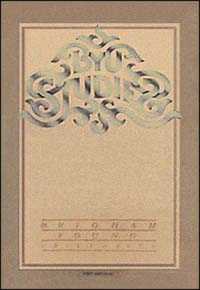
|
|
Richard S. Van Wagoner
Sidney Rigdon... (SLC: Signature Books, 1994) Signature Books, all rights reserved. Limited "fair use" excerpts presented here. |
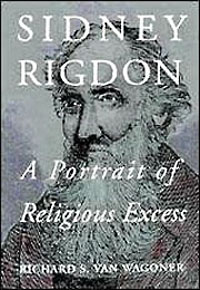
|
|
SIDNEY RIGDON A P o r t r a i t o f R e l i g i o u s E x c e s s BY Richard VanWagoner SIGNATURE BOOKS -- SALT LAKE CITY 1994 |
Note: Because of copyright law restrictions,
only limited "fair use" excerpts are presented here.
(This text's original endnotes have been reformatted.)
 Sidney Rigdon's
Sidney Rigdon's1873 Letter to Chs. L. Woodward Letter in New York Public Library (Originally located in the Woodward Collection, but later moved to the Library's manuscripts collection)
From William A. Linn, 1902: "One person succeeded in drawing out from Rigdon in his later years a few words on his relations with the Mormon church. This was Charles L. Woodward, a New York bookseller, who some years ago made an important collection of Mormon literature. While making this collection he sent an inquiry to Rigdon, and received a reply, dated May 25, 1873. The original of this letter is in the collection of Mormon literature in the New York Public Library. An effort to learn from Rigdon's descendants something about the manuscript paper referred to by him has failed." See also Riley, 1903 |
|
Transcriber's Comments
(under construction) |
Return to top of the page
Sidney Rigdon Home Page | Rigdon's History | Mormon Classics E-Texts
last revised Apr. 3, 2006
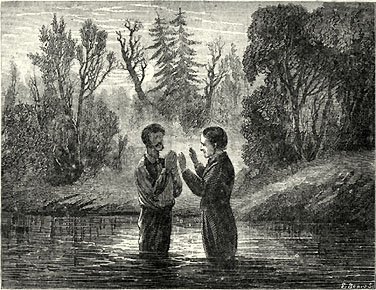
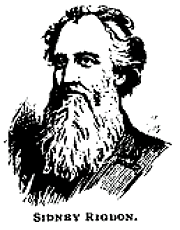 Sidney Rigdon was their
chief "seer" and prophet. He was also high priest as well as prophet. The commodious barn on the rolling
meadow was the "temple," and the "temporal abode" for Rigdon and his assistant priests, Kimball [sic] and
Hyde [sic!].
Sidney Rigdon was their
chief "seer" and prophet. He was also high priest as well as prophet. The commodious barn on the rolling
meadow was the "temple," and the "temporal abode" for Rigdon and his assistant priests, Kimball [sic] and
Hyde [sic!].
